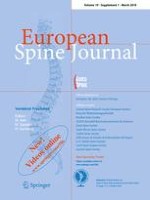Erschienen in:

01.03.2010 | Review Article
Surgical treatment of post-traumatic kyphosis in the thoracolumbar spine: indications and technical aspects
verfasst von:
Everard Munting
Erschienen in:
European Spine Journal
|
Sonderheft 1/2010
Einloggen, um Zugang zu erhalten
Abstract
Indications for correction of post-traumatic kyphotic deformity of the spine and technical aspects of the surgical procedure are reviewed. Surgical correction of post-traumatic deformity of the spine should be considered in patients presenting a local excess of kyphosis in the fractured area superior to 20° with poor functional tolerance. Severe pain, explained by objective factors such as canal or neuroforamen compromise with or without peripheral symptoms, angular deformity, non-union, focal instability, adjacent painful compensatory deformity such as lumbar hyper-lordosis or thoracic hypo-kyphosis or lordosis is a further argument for surgery. More advanced age, litigation, work-related trauma are negative factors. Planning of the surgical procedure includes the choice of the approach(es), the corrective means: subtraction osteotomy or vertebral body reconstruction and the nature and extent of osteosynthesis and fusion. Decision-making factors includes: level of trauma, severity of deformity, history of previous surgery in the area of deformity, bone quality, age of fracture. Corrective surgery of a post-traumatic deformity of the spine is a difficult procedure that should be considered only by an experienced team, after careful consideration of the indication and with the consent of a well-informed patient. Complications do occur and lead to the need of re-intervention in up to 10% of our cases. However, significant complications with lasting consequences did not occur in our experience. The more severe is the deformity, the better are the chances to improve the patient, as long as the surgical goals are fulfilled.